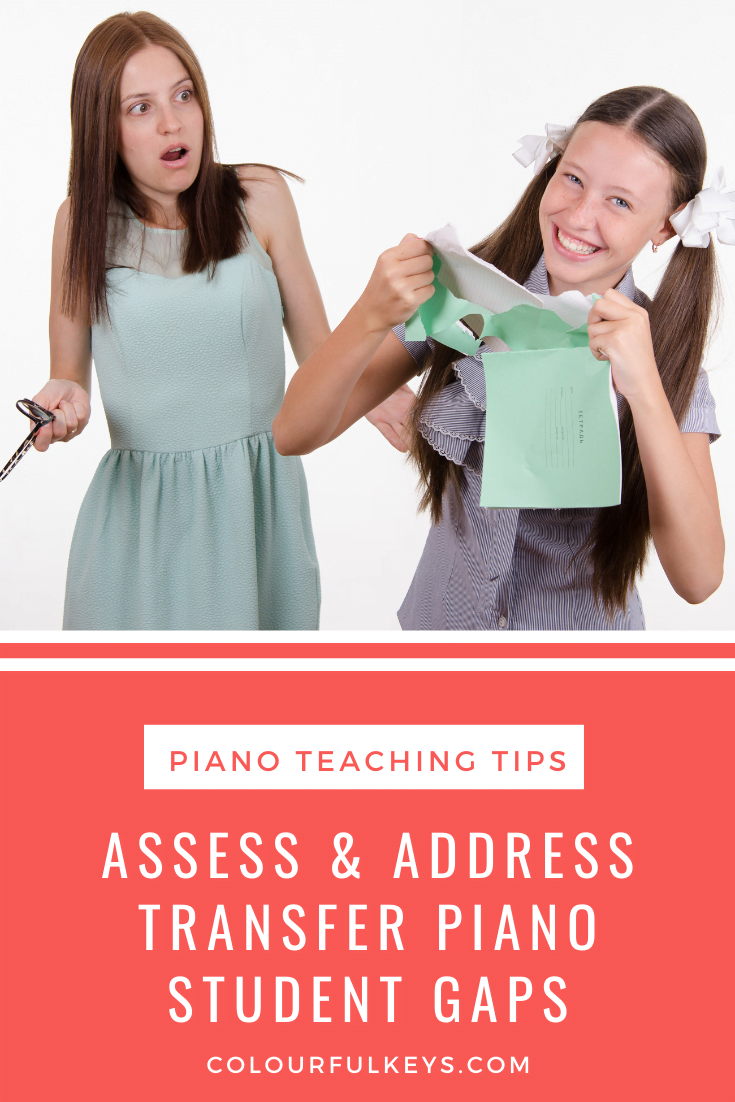A new piano transfer student has just arrived at your piano studio. How do you assess where they are? They might say they’re a grade 3, or that they finished a certain book…but that doesn’t mean they know everything you might expect at that level. So here are 7 great ways to find gaps in the skills of your new transfer piano student.

⬆️ Listen to the podcast above or keep on reading, whichever fits your style. ↙️
Students don’t progress in every area at the same rate. And teachers don’t teach concepts in the same order.
Which leads us into a tangled weave when it comes to taking on a transfer student.
You might get a student who’s playing a Chopin prelude and move forward assuming they understand the notation…only to discover later they don’t know what an interval is.
Or maybe you get a student who seems like a strong reader, but the first time you ask them to play something they’ve never heard, they freeze. Turns out they can’t decode rhythms; they’re just remembering them very well once they’ve heard them.
Wouldn’t you prefer to know these things sooner rather than later?
Even in milder cases of missing knowledge, it’s better to have a plan to address it rather than scrambling and backpedalling later.
First, talk goals.
Before we get going on these tools, make sure you’ve talked to this student about their goals. It won’t do any good to find a reading gap and work to fix it if they don’t want to read.

I’m not saying we should give up on reading for every teen who says they don’t want to. But you need to meet the student where they’re at first.
Most of all, you need to make sure they feel seen and heard. Listen to their motivation and let them know how you’ll get them where they want to go.
Now that you’re on the same metaphorical goal-page, let’s get them on the same manuscript page. Here are 7 great tools to help you to find and fill your transfer piano student’s gaps.
#1 Student Sleuth
We have a special tool inside Vibrant Music Teaching to help you see where how any student is tracking in each core area of music study.
If you want to see what it’s all about, watch the video below.
I recommend using this when you’re a few lessons in with your transfer student and you’ve used some of the other gap assessment tools below. Once you’re ready, click here to get started.
Not a member of Vibrant Music Teaching? Wow, you’ve got to see what you’re missing. Check it out and join the fun today!
#2 Method Book Dash
A quick race through a method book can be a great way to see where your student’s reading is up to.
I like to do this with Piano Pronto myself, but it can be done with any method.
- Open up to the middle of the primer and have them play the piece, with the teacher duet if it has one.
- If that goes well, skip ahead 20 pages and try that piece.
- Continue doing this (through multiple levels of the method) until you reach a point where it’s a challenge for your student to read it.
Before you start this – make sure your student knows what’s happening!
Tell them that this is a game you play with all transfer students to get to know each other better musically. You don’t want them to think you’re putting them back to the beginning and sticking them with Mary and her sheep. 🐑
#3 Chats
Sometimes others know us better than we know ourselves. Make sure to have a quick conversation with each of these people when you take on a new transfer student:
The Previous Teacher
Some teachers are happy to produce a handover report or field a few questions. Even if things ended on not-so-great terms, teachers want the best for our students.
Call up or email the previous teacher and ask how they got on with this student.
- Was there anything in particular they had trouble with?
- Did they find certain styles of teaching worked better than others?
On rare occasions, things might have ended acrimoniously and you won’t have much luck on this front. But it’s always worth a try.
The Student
If the student is old enough, they might know which areas they feel they need to improve. Ask what aspects of piano they’ve struggled with and which parts they enjoyed the most.

Also enquire about their hobbies and interests in school. This can reveal a lot about what motivates them and how they tick. It’s also just a great opportunity to get to know them and start to build the new relationship. 😊
The Parent
Parents often know how well their child connected and engaged in piano lessons, what the student enjoyed, and what they liked to practise at home. This is a gold mine for finding out what the student has been working on…and what they haven’t.
Be sure to ask the parent about this at the first meeting.
The parent can also fill you in on the general family experience with music. Ask if they listen to music at home and if their child sings along to music or songs. These things will give you a general baseline for the student’s comfort with pitch and pulse.
#4 Games
I’ve put my favourite in the middle. ❤️
Games are my number 1 tool for assessing transfer student gaps. By playing games together you’ll get to see which concepts they get and don’t get without it feeling like a test.
Games are also a wonderful way to get to know your student and have some fun together in the first lessons. Win win all around.
If you need games for your new transfer student, we have you covered in the Vibrant Music Teaching Printable Library. Select any topic and you’ll have a smorgasbord of options to choose from.
If you’re not a member of Vibrant Music Teaching yet, sign up here to access all these great games and so much more.
#5 Exam Reports
If your students took exams, exam reports are an excellent source of comments from a professional which can highlight areas of musicianship which may need some attention.
Examiners will often comment on general preparation levels as well, which could flag a lack of practice.
As with all these tools, it’s not about tarring the student with a certain brush. We’re just finding out some areas which we might want to check in on, so we can give this student the maximum chance of success.
#6 Give Them a Challenge
Don’t do this in the first lesson. But once they get settled in, this is a great way to assess their mindset.
Do they give up easily, or are they persistent?
This is an important gap to find because being gritty is a key part of practice and progress at the piano.
To develop their grit, we have a special series for that called Gritty Critters. These games focus on skills like grit, mindfulness and growth mindset, and students love them! Start with Yeti Yetters and go from there.
#7 Follow a Curriculum
If you end up really unsure of where the gaps are with your new transfer piano student, it’s best to follow a curriculum so you can be sure they all get filled in.

Subscribe to the newsletter and get the Curriculum Kickoff challenge
Enter your details to subscribe to the newsletter for piano teachers with information, tips and offers.
I hate spam as much as you do! I will only send you emails related directly to piano teaching and you can unsubscribe at any time.
If you don’t have a curriculum of your own yet, the Piano Powerbooster plans in Vibrant Music Teaching are a great place to start. These focus on everything outside of the repertoire so you can continue working on pieces your student is excited about while also covering all the technique, theory, rhythm and aural bases.
You’ll find more resources about planning awesome music lessons on my centralised page devoted to Planning Lessons.
Bonus Tip: Don’t Forget the Fun!
Remember not to get too bogged down in the gaps with your transfer piano student. They’re still an exciting new student, and you should have fun together!
Keep those gaps in the back of your mind and plan to fill them in over time. But in the moment, focus on the music and the magic which comes with it.
What transfer piano student gaps do you find cropping up repeatedly?
I’d love to hear your thoughts on this (and, yes, maybe pet peeves) in the comments below. 🙂

I recently took on two lovely girls, ages 10 and 12. I’ve quickly learned that their previous teacher only taught them by playing a piece for them a few times and having the girls listen and copy! These two students really know very little theory and can identify very few notes on the staff. While it is good to develop our ear, I feel this was a disservice to them.